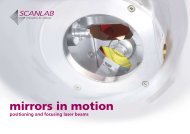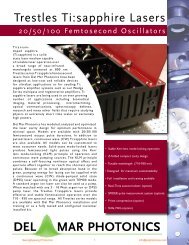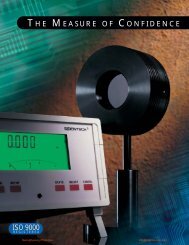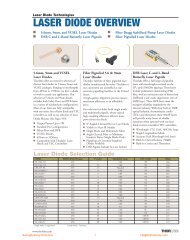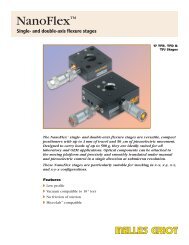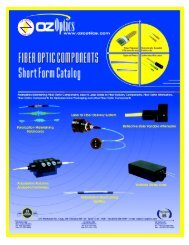SAM – saturable absorber mirror
SAM – saturable absorber mirror
SAM – saturable absorber mirror
- No tags were found...
Create successful ePaper yourself
Turn your PDF publications into a flip-book with our unique Google optimized e-Paper software.
Refractive index > GaAs | AlAs | Al x Ga 1-x As | In x Ga 1-x As> Devices > Bragg <strong>mirror</strong> | <strong>SAM</strong> | R<strong>SAM</strong> | SANOS | SOC | PCASANOS - Saturable Noise Suppressor> Contents● How works a SANOS?● SANOS applications● Free space SANOS● Fibre coupled SANOS● Effective saturation fluence Φ sat,eff●●●Relaxation time constant τEffective saturation intensity I sat,effBandwidth> How works a SANOS?The active element of a SANOS is a resonant<strong>saturable</strong> <strong>absorber</strong> <strong>mirror</strong> (R<strong>SAM</strong>) with zeroreflectance for a low power signal at theresonance wavelength. The R<strong>SAM</strong> is anonlinear optical device, having a lowreflectance for week optical signals like noiseand a high reflectance for high power signalslike optical pulses.A typical non-linear transfer function of aSANOS is shown in the figure left. Thetransmittance of the SANOS is shown as afunction of the peak puls intensity I. Thetypical effective saturation intensity I sat,eff is~2 MW/cm 2 .A SANOS is mainly characterized by the following parameters:●●●●●the effective saturation fluence Φ sat,effthe relaxation time constant τthe effective saturation intensity I sat,effthe usuable spectral bandwidth ∆λthe insertion loss L> SANOS applicationsSeongKyeong Photonics 22 info@skphotonics.com




